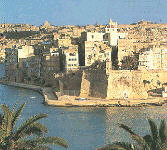|
There
is one destination in Europe, sadly enough, that tends not
to draw as many vacationers as it might. Malta, a quintessentially
Mediterranean destination, contains such a variety of attractions
that everywhere you turn there are delightful things to see
and do. The two islands of Malta and Gozo contain a greater
concentration of impressive architectural and archaeological
sites in relation to their size than perhaps anywhere else
in the world. These sites remind the visitor of the islands'
strategic position in the centre of the Mediterranean Sea,
which resulted in their repeated occupation by foreign powers
over the many centuries. What follows is an irreducible summary
of the tourism highlights.
Valetta, scarcely unchanged architecturally from its appearance
in the seventeenth century, was the centre of the Knights
of St. John. They made Malta their base for nearly 250 years,
from 1530 to 1798. Their sixteenth century church, St.John's
Co-Cathedral, is a major site, noteworthy for its splendid
Baroque interior, varied frescoes, marble tombstones and chapels
filled with treasures.
The
Auberge de Castille, Leon et Portugal, formerly the home of
the Knights of the Spanish and Portuguese Langue, currently
serves as the office of the Maltese Prime Minister.
Upper Barraca Gardens, once the private garden of the
Italian Knights, is a vantage point for superb views of the
Grand Harbour and the Cottonera, Auberge de Provence, the
site of the National Museum of Archaeology, was constructed
in 1574 as a mansion housing the French Knights of Provence.
The
Grandmaster's Palace, a late, sixteenth century building,
originates from the earliest years of the Order's stay in
Malta. Home of the Maltese Parliament, it should be visited
for its impressive Armoury. The Manoel Theatre, (1731), one
of the oldest in Europe, is an architectural gem, so be sure
to take it in on a guided tour. Auberge d'Italie, the former
palace of the Knights of the Italian Langue, dates from 1574.
A
tour of The Hospital of the Order, built in 1532, is a truly
unforgettable experience. Here the Knights, as part of their
vows, cared for their patients, admitted as patients regardless
of their social and economic position within Maltese society.
In this building you can view the audio-visual
presentation called
"The Malta Experience". Not far from here
is Fort St. Elmo and its military museum, offering a permanent
exhibition of displays related to World War Two.
Added
local attractions include the Jesuit Church, called "Chiesa
di Gesu", the Opera House, Plazzo Ferreria, Admiralty
House and Museum of Fine Arts and numerous other churches.
In Valetta a recommended place to stay is the Park Hotel.
The hotel's restaurant features first rate buffet breakfasts
and its lobby is spacious and comfortable. The hotel is also
handy to many nearby restaurants.
Outside
of the capital is delightful Mdina, Malta's capital before
the Knights arrived. Hours can be spent strolling along the
streets and admiring the historic sites, among the most prominent
of them, Palzo Faizon, called Norman House; the Cathedral;
and the Archbishop's Palace, dating from 1722. In addition,
you won't want to miss Casa Iguanez, Carmelite Church, Bastion
Square, the Nunnery of St. Benedict, Palazzo Vihena and St.
Paul's Square. Nearby Rabat features the Museum of Roman Antiquities,
St. Paul's Church and St. Agatha Catacombs.
Gozo,
reached by scheduled ferry service, is a great place to unwind.
The charming island, much more rural and relaxing, is mostly
a home to farmers
and fishermen. The principal sights are the cathedral, the
archaeological museum in Victoria, the capital; Ggantija Temple
Complex near Xaghra village; and the resort town of Marsalforn.
Recommended is the Grand Hotel, a lovely property that makes
a sojourn in Gozo even more enjoyable. The hotel, overlooking
the sea, has a spacious lobby, a fine restaurant and a large
swimming pool. Air
Malta is the air carrier that operates to the island from
most major cities and capitals in Europe.
home
| next
|